The Gulf of Saint Lawrence
The Huron Jewel has just sailed 815 nautical miles (938 statue miles or 1509 km) from Quebec City, out the Saint Lawrence Seaway, across the Gulf of Saint Lawrence, through the Canso Strait, into the Atlantic Ocean, and down the coast of Nova Scotia to the port of Lunenburg in 7 days and 9 hours — including 3 brief overnight anchorages. Whew! Now, the crew gets a well-deserved rest, and I’ve got wifi so I can post a voyage update. (The two flags above are from Prince Edward Island and Nova Scotia, the two provinces where we spent most of our time.)
During this passage, I’ve learned that weather is a major factor at sea. A good captain, like the one we’ve got, knows how to use the good winds and avoid the bad ones. Temperature is also critical. A few hours after we left Quebec City, upwelling ocean currents lowered the water temperature to a frigid 45°F (7°C). I had to use my Covid mask while at the helm one morning to keep my nose from freezing off.
Weather can change quickly. Twenty-four hours later on the Gulf of Saint Lawrence, the crew enjoyed a balmy breakfast on deck.
From Quebec City to Lunenburg, we sailed or motored almost continuously. To maintain progress 24 hours a day, the crew was divided into three watch teams. We rotated helm and work assignments with a modified Swedish watch schedule like this:
Under this schedule, Thomas and I started with a morning watch from 7am to noon, followed by a midnight watch from 10pm to 3am. On the second day, we stood an afternoon watch from noon until 5pm. On the third day, we were at the helm from 3am until 7am, followed by an evening watch from 5pm to 10pm. After that, the cycle begins again. It was a good way to divide the work and give everyone ten hours of rest between watches.
Julie has the most important job on board! She produces excellent meals three times a day as well as snacks and hot beverages. She hasn’t duplicated a dinner menu yet. Julie is shown here as we pass iconic Percé Rock at the tip of the Gaspé Peninsula.
We’ve enjoyed lots of beautiful scenery along our cruise. We’ve also seen plenty of marine life in the Gulf of Saint Lawrence.
In addition to the pinnipeds and cetaceans, there are thousands of sea birds like the Northern Gannet shown here flying past Prince Edward Island.
Halfway across the Gulf of Saint Lawrence, we passed under the curved 8-mile (13km) Confederation Bridge, the longest bridge in the world that crosses ice-covered water. This bridge connects Prince Edward Island with mainland Canada.
The next obstacle we encountered were miles and miles of lobster pots in the shallow waters south of Prince Edward Island.
We had to be careful not to run over the buoys tethered to wire-mesh lobster traps on the ocean floor. This required hours of careful steering to avoid fouling our propellers with buoys and lines.
Until now, much of our journey was through the locks and channels of the Saint Lawrence River where we had to use our motors. When we got to the Gulf of Saint Lawrence, we were finally able to raise sails and see how fast the Huron Jewel can go.
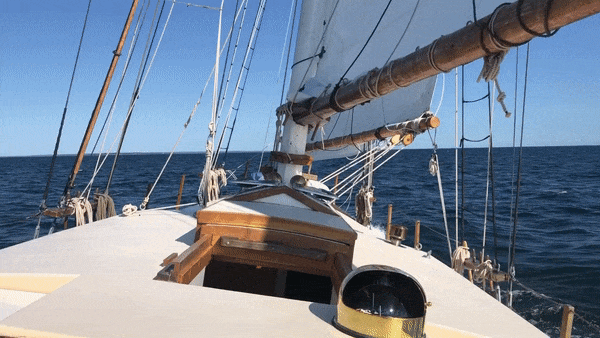
Thomas and I were lucky enough to have the evening watch on the night of the full moon. Our course that evening was due east. As the moon rose, I had the unforgettable experience of Sailing Along on a Moonbeam.
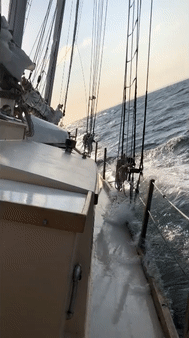
But this magical tranquility didn’t last. When we came out from behind the wind shadow of Prince Edward Island, we encountered heavy winds and high waves. We took refuge in Ballantynes Cove until daylight. Even the next morning, the going was rough. We were healed over as much as 35° and had water over the toe rails.
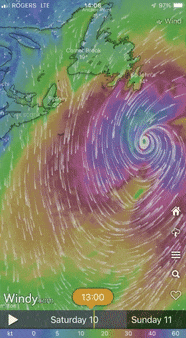
Why were the winds so fierce and the seas so high? Ahead of us was a threatening storm that looked like this on windy.com. Captain Hugh did what any experienced sailor would do: Take shelter until the storm passed. After slipping through the Canso Strait, we anchored for a night among islands in Canso Bay — while winds whistled in the pines.
The next morning the water in our protected anchorage was like glass — a welcome break from the rough seas we’d sailed through the day before! By noon, the storm broke up and drifted off to the northeast.
This was our opportunity to exit Canso Bay into the Atlantic where the ocean was calm enough to relax on deck with a good book.
That evening, as we cruised down the coast of Nova Scotia, we had a sublime sunset. Red sky at night, sailor’s delight.
After a gentle sail through the night and into the next day, we docked in the port of Lunenburg. I’ll say more about this picturesque and historic fishing port in my next — and final — travel blog. Yes, this voyage will end soon. Sometime next week, we’ll reach Camden, Maine where I’ll say a fond farewell to my amiable crewmates and the beautiful Huron Jewel. Stay tuned for one more posting.

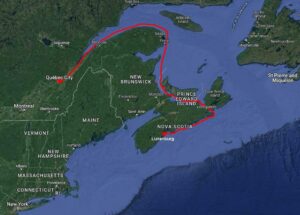

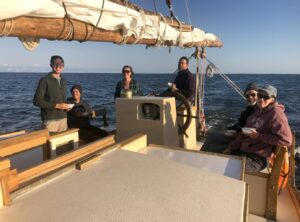

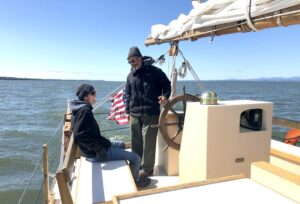
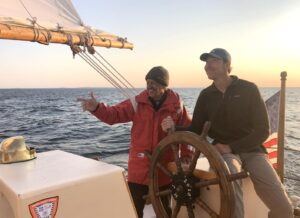

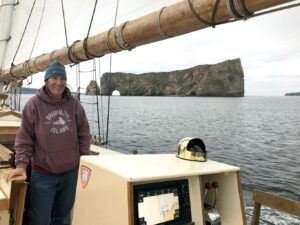



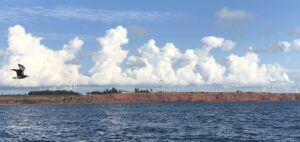
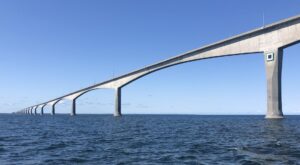

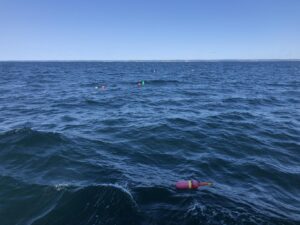

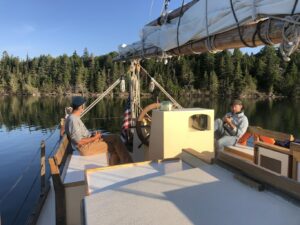
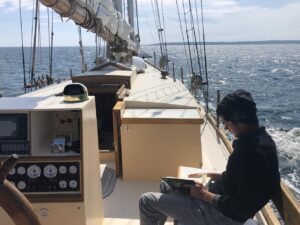

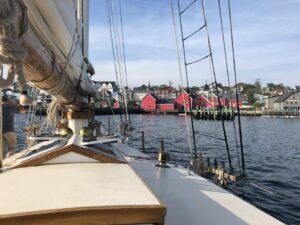
As a sailor, I really enjoyed this blog. Stay safe. I am off to Batumi next week, then Iraq.
Well, what a delightful trip. The boat began just east of where my youngest now lives, one state over, and passed my birthplace as you crossed Lake Ontario after skipping past where my parents honeymooned in Niagara Falls. On through the Thousand Islands that my children and I know so well and a visit to Old Quebec passing another first cousin of mine who seems to spend a lot of time on Isle D’Orleans where my ancestor Captain Fortier quit the sea in 1625. My husband’s step mother has a place in Lunenberg where they spend most summers, no longer sailing due to age related difficulties. But, with all of that, sharing part of your journey with the Pride of Baltimore really brings your journal close to home. I won’t be attending your talk, but I expect it will be delightful. Bravo.
Want to hear about Lunenburg. I ‘ve been wanting to go to Nova Scotia for a while. I hear it’s very pretty and not so crowded as Maine.
Great trip. I really enjoyed your description of the trip. Keep on’ truckin’!
Wow Great Voyage!! My Dad Is from Gaspe , he used to tell me when he was a kid on the coast during the WW2 that area was used by convoys going to England and Russia with war supplies. He witnessed more than one UBoat attack My dad and his father would row out to try to rescue survivors. As always great stories Nic looking forward to the next one. Glad we met you and the Huron Jewel at the re enactment in penatangusine. A couple of years ago. Take care. Dana
Hello Nic!
Great post. I like the map that you posted detailing the journey. That was my first thought. Thank you for the pics of the dolphins and whales and seals. You already know how I love the dolphins and whales. All of the pics allow us to live vicariously through you. The fishing village, the sailing pics, the sunsets and moonbeams, and the crew, of course, are just totally enjoyable to witness.
Nick:
Great … now that Christopher Cross song is stuck in my head. Thanks, Nick! :-+
P.S. Enjoyed your chronicle, as always 🙂
Lots of action on this leg of your journey. It made for good reading in California.